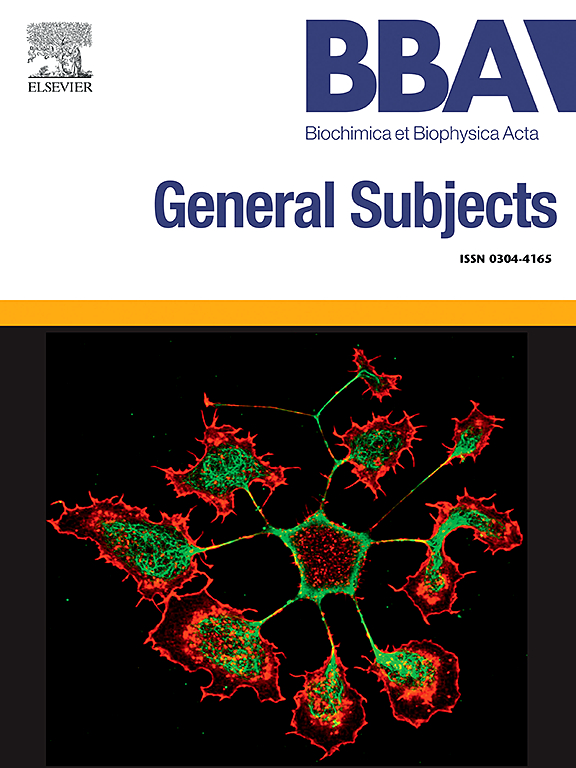Functions of unique middle loop and C-terminal tail in GnT-III activity and secretion
IF 2.8
3区 生物学
Q3 BIOCHEMISTRY & MOLECULAR BIOLOGY
Biochimica et biophysica acta. General subjects
Pub Date : 2025-01-01
DOI:10.1016/j.bbagen.2024.130734
引用次数: 0
Abstract
Background
N-Glycan branching modulates the diversity of protein functions. β1,4-N-acetylglucosaminyltransferase III (GnT-III or MGAT3) produces a unique GlcNAc branch, “bisecting GlcNAc”, in N-glycans, and is involved in Alzheimer's disease and cancer. However, the 3D structure and catalytic mechanism of GnT-III are unclear. According to AlphaFold-based structure prediction, GnT-III likely contains two putative disordered segments, a long middle loop (Loop) and a C-terminal tail (Tail). We hypothesized that these segments play important roles in regulating the activity or intracellular behaviors of GnT-III.
Methods
We expressed wild-type GnT-III (GnT-III-WT), GnT-III-Loop- and -Tail-deletion mutants in cells. Their in vitro catalytic activity and glycan biosynthesis in cells were examined using high-performance liquid chromatography, UDP-Glo glycosyltransferase assays, and glycomic analysis. Subcellular localization of WT and GnT-III mutants was investigated by immunostaining, and degradation rate and secretion were also examined.
Results
The Loop-deletion mutant had higher in vitro and in cellulo activity than GnT-III-WT, indicating that Loop suppresses catalytic activity. In contrast, the Tail-deletion mutant showed weaker activity, increased ER localization, and faster degradation than GnT-III-WT, indicating that Tail is required for proper folding. In addition, deletion of Loop led to aberrant shedding of GnT-III, indicating that Loop contains the cleavage site or regulates GnT-III shedding.
Conclusions
Loop and Tail of GnT-III play important roles in catalytic activity, folding and shedding.
General significance
Our results provide further understanding of the catalysis and shedding mechanisms of GnT-III and can help in the development of methods for modifying the levels of bisecting GlcNAc on glycoproteins and in cells.

独特的中环和c端尾在GnT-III活性和分泌中的作用。
背景:n -聚糖分支调节蛋白质功能的多样性。β1,4- n -乙酰氨基葡萄糖转移酶III (GnT-III或MGAT3)在n -聚糖中产生独特的GlcNAc分支,“分割GlcNAc”,并参与阿尔茨海默病和癌症。然而,GnT-III的三维结构和催化机理尚不清楚。根据基于alphafold的结构预测,GnT-III可能包含两个假定的紊乱片段,一个长中间环(loop)和一个c端尾部(tail)。我们假设这些片段在调节GnT-III的活性或细胞内行为中发挥重要作用。方法:我们在细胞中表达野生型GnT-III (GnT-III- wt), GnT-III- loop和- tail缺失突变体。采用高效液相色谱法、UDP-Glo糖基转移酶法和糖偶联分析法检测了它们的体外催化活性和细胞内的聚糖生物合成。通过免疫染色研究WT和GnT-III突变体的亚细胞定位,并检测其降解率和分泌量。结果:与GnT-III-WT相比,环缺失突变体具有更高的体外和纤维素活性,表明环抑制了催化活性。相比之下,Tail缺失突变体比GnT-III-WT表现出更弱的活性,ER定位增加,降解速度更快,这表明Tail是正确折叠所必需的。此外,Loop的缺失导致GnT-III的异常脱落,表明Loop含有裂解位点或调节GnT-III的脱落。结论:GnT-III的环和尾在催化活性、折叠和脱落中起重要作用。一般意义:我们的研究结果进一步了解了GnT-III的催化和脱落机制,并有助于开发修改糖蛋白和细胞中分割GlcNAc水平的方法。
本文章由计算机程序翻译,如有差异,请以英文原文为准。
求助全文
约1分钟内获得全文
求助全文
来源期刊

Biochimica et biophysica acta. General subjects
生物-生化与分子生物学
CiteScore
6.40
自引率
0.00%
发文量
139
审稿时长
30 days
期刊介绍:
BBA General Subjects accepts for submission either original, hypothesis-driven studies or reviews covering subjects in biochemistry and biophysics that are considered to have general interest for a wide audience. Manuscripts with interdisciplinary approaches are especially encouraged.
 求助内容:
求助内容: 应助结果提醒方式:
应助结果提醒方式:


